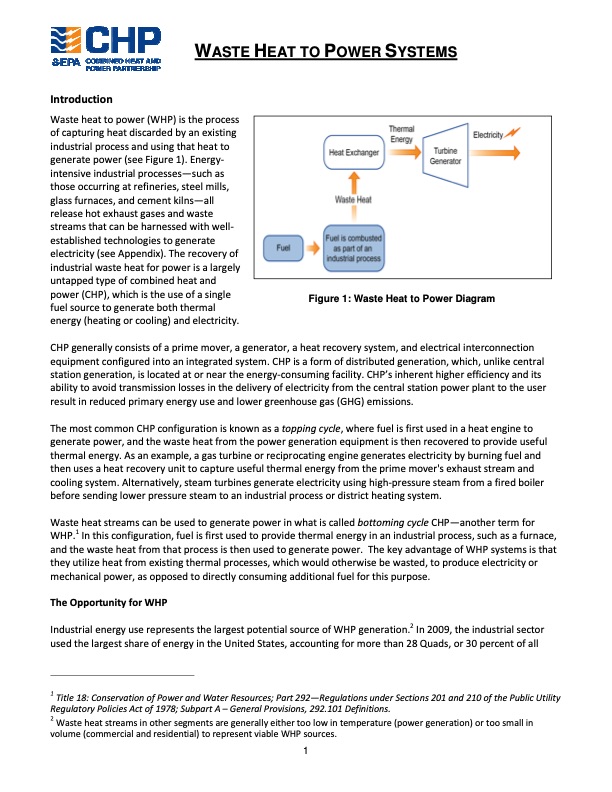
PDF Publication Title:
Text from PDF Page: 001
Introduction Waste heat to power (WHP) is the process of capturing heat discarded by an existing industrial process and using that heat to generate power (see Figure 1). Energy- intensive industrial processes—such as those occurring at refineries, steel mills, glass furnaces, and cement kilns—all release hot exhaust gases and waste streams that can be harnessed with well- established technologies to generate electricity (see Appendix). The recovery of industrial waste heat for power is a largely untapped type of combined heat and power (CHP), which is the use of a single fuel source to generate both thermal energy (heating or cooling) and electricity. Figure 1: Waste Heat to Power Diagram WASTE HEAT TO POWER SYSTEMS CHP generally consists of a prime mover, a generator, a heat recovery system, and electrical interconnection equipment configured into an integrated system. CHP is a form of distributed generation, which, unlike central station generation, is located at or near the energy-consuming facility. CHP’s inherent higher efficiency and its ability to avoid transmission losses in the delivery of electricity from the central station power plant to the user result in reduced primary energy use and lower greenhouse gas (GHG) emissions. The most common CHP configuration is known as a topping cycle, where fuel is first used in a heat engine to generate power, and the waste heat from the power generation equipment is then recovered to provide useful thermal energy. As an example, a gas turbine or reciprocating engine generates electricity by burning fuel and then uses a heat recovery unit to capture useful thermal energy from the prime mover's exhaust stream and cooling system. Alternatively, steam turbines generate electricity using high-pressure steam from a fired boiler before sending lower pressure steam to an industrial process or district heating system. Waste heat streams can be used to generate power in what is called bottoming cycle CHP—another term for WHP.1 In this configuration, fuel is first used to provide thermal energy in an industrial process, such as a furnace, and the waste heat from that process is then used to generate power. The key advantage of WHP systems is that they utilize heat from existing thermal processes, which would otherwise be wasted, to produce electricity or mechanical power, as opposed to directly consuming additional fuel for this purpose. The Opportunity for WHP Industrial energy use represents the largest potential source of WHP generation.2 In 2009, the industrial sector used the largest share of energy in the United States, accounting for more than 28 Quads, or 30 percent of all 1 Title 18: Conservation of Power and Water Resources; Part 292—Regulations under Sections 201 and 210 of the Public Utility Regulatory Policies Act of 1978; Subpart A – General Provisions, 292.101 Definitions. 2 Waste heat streams in other segments are generally either too low in temperature (power generation) or too small in volume (commercial and residential) to represent viable WHP sources. 1PDF Image | waste heat to power systems

PDF Search Title:
waste heat to power systemsOriginal File Name Searched:
waste_heat_to_power_systems.pdfDIY PDF Search: Google It | Yahoo | Bing
NFT (Non Fungible Token): Buy our tech, design, development or system NFT and become part of our tech NFT network... More Info
IT XR Project Redstone NFT Available for Sale: NFT for high tech turbine design with one part 3D printed counter-rotating energy turbine. Be part of the future with this NFT. Can be bought and sold but only one design NFT exists. Royalties go to the developer (Infinity) to keep enhancing design and applications... More Info
Infinity Turbine IT XR Project Redstone Design: NFT for sale... NFT for high tech turbine design with one part 3D printed counter-rotating energy turbine. Includes all rights to this turbine design, including license for Fluid Handling Block I and II for the turbine assembly and housing. The NFT includes the blueprints (cad/cam), revenue streams, and all future development of the IT XR Project Redstone... More Info
Infinity Turbine ROT Radial Outflow Turbine 24 Design and Worldwide Rights: NFT for sale... NFT for the ROT 24 energy turbine. Be part of the future with this NFT. This design can be bought and sold but only one design NFT exists. You may manufacture the unit, or get the revenues from its sale from Infinity Turbine. Royalties go to the developer (Infinity) to keep enhancing design and applications... More Info
Infinity Supercritical CO2 10 Liter Extractor Design and Worldwide Rights: The Infinity Supercritical 10L CO2 extractor is for botanical oil extraction, which is rich in terpenes and can produce shelf ready full spectrum oil. With over 5 years of development, this industry leader mature extractor machine has been sold since 2015 and is part of many profitable businesses. The process can also be used for electrowinning, e-waste recycling, and lithium battery recycling, gold mining electronic wastes, precious metals. CO2 can also be used in a reverse fuel cell with nafion to make a gas-to-liquids fuel, such as methanol, ethanol and butanol or ethylene. Supercritical CO2 has also been used for treating nafion to make it more effective catalyst. This NFT is for the purchase of worldwide rights which includes the design. More Info
NFT (Non Fungible Token): Buy our tech, design, development or system NFT and become part of our tech NFT network... More Info
Infinity Turbine Products: Special for this month, any plans are $10,000 for complete Cad/Cam blueprints. License is for one build. Try before you buy a production license. May pay by Bitcoin or other Crypto. Products Page... More Info
| CONTACT TEL: 608-238-6001 Email: greg@infinityturbine.com | RSS | AMP |